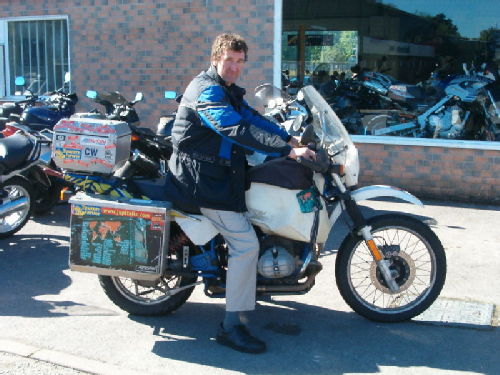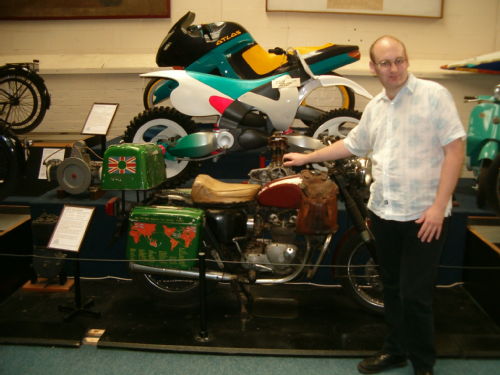All entries for Thursday 26 May 2005
May 26, 2005
Meeting a famous bike
Follow-up to Ted Simon and the art of deterritorialization from Transversality - Robert O'Toole
My GS met up with an old friend at CW's at the weekend. Last February, after I got hit on the head by a rock on a Catalan motorway, it spent several months in the garage at CW's sitting next to a more distinguished GS: that ridden by Ted Simon on his latest round the world ride, soon to be documented in the much awaited book "Dreaming of Jupiter".
Ted's bike is a little more battered (well used) despite being younger than mine. It has of course ridden across Europe, Africa, South, Central and North America, Australia and Asia. So you can excuse a few dents. I expect that it does still run well.
After checking with Dave (and on the basis that I'm a member of the Order of Jupiter), we took a few photos. Here's me on the bike:

And Martin:

Notice the photo on the side of the pannier, which is of the world map on the side of Ted's original round the world bike from 1972, which is now in Coventry's Transport Museum:

And finally, a photo of our three bkes:

CMap free concept mapping tool
Writing about web page http://cmap.ihmc.us/
I have decided to move my research work from the very professional MindManager software to the slightly less slick but more accessible (as in free) CMap software.
Concept mapping is an essential part of how I work, both in philsoophy and in e-learning. For sometime now I have been building concept maps, and using them for presentations, using the excellent Mindjet MindManager. This is a very slick and professional product, with integration into Microsoft Word, PowerPoint and Project. In fact, it seems to have strong project management functionality (something I never use, even for big projects). You can see an example of a MindManager map in my ePortfolio.
After investigating various other applications, I have decided to switch to CMap. This is mainly a result of the need to get more people at Warwick creating and sharing maps. Although MindGenius and Inspirations are available on university computers, I have chosen CMap as it is much more appropriate to research work. Some advantages are:
- free, but not open source, whereas MindManager costs about £80 (with an educational discount);
- versions for Windows, Linux and Mac (MindManager is Windows only);
- not a rigid tree structure, sub-nodes can be joined to sub-nodes by standard 'propositions', making the maps more like a rhizomatic network than an arborescent hierarchy (that's philosophically correct then);
- drag-and-drop linking between nodes in different maps;
- CMap collaboration server available, for sharing and version controlled co-development of maps – also includes chat and versioning (not investigated yet).
The thing that I might miss from MindManager is the ability to easily hide nodes (and their subnodes). Each parent node in MindManager has a plus sign next to it. Clicking on the plus hides or unhides the node. This is useful when dealing with a complex map, but also when using a map in a presentation. My technique is to start with the high level nodes, and then reveal the detail in turn. It may be that this feature actually encourages me to put too much detail on a single map. Using the inter map linking feature in CMap, I will be able to move the detail out into seperate maps. Perhaps this will also help me in structuring my ideas more effectively.
Interestingly, the first maps that I looked at from CMap's own server were on exactly the topics that I am researching: autopoiesis and complexity.
You can download CMap for free.
What are ePortfolios for?
Writing about web page http://www.cetis.ac.uk/members/scott/blogview?entry=20050523083528
What is an ePortfolio? Is it necessarily tied up with questions of interoperability and automation of content?
At Warwick we have been experimenting with providing for our students, initially at the PhD level, a structured set of personal web pages within which they can represent their academic activities. This is constructed using our Sitebuilder CMS, along with other tools such as Warwick Blogs. We have been calling this an "ePortfolio", that is, an online portflio of work and recordings of experience and achievements. The aim has been for these to exist within the student's home department web site.
Several seperate interests have motivated this:
- for the student themselves – that the reflective process of building the ePortfolio is useful for the student. It also provides a useful way for the student to distribute their work within and beyond the university;
- for the department and the university – representing what PhD students are doing demonstrated the wealth of research at Warwick;
- for research councils and other funders to see what their students are doing.
As a result of these interests, our interpretation of 'ePortflio' is of something that exists within the context of the university, and as close as possible to the context in which the student is working. It is also a selective portfolio, presenting to the various specific audiences a carefully defined narrative – a story tied closely to the departmental context.
In his presentation on ePortfolios, Scott Wilson of Cetis (the UK body most concerned with interoperability), does a good job of outlining some of the usefulness of ePortfolios. However, he makes the increasingly common claim that a:
key requirement is the ability to export across transitions
Certainly in our case, I don't agree with that. I would argue that a key outcome of an education at the level of Warwick is the ability of a graduate to communicate effectively a selected overview of their work to each specific audience as required. If a detailed breakdown of skills and knowledge is required, the graduate should be capable of presenting that themselves, in their own way or within the bounds specified by the relevant professional body. This may be accompanied where necessary by references to authoratitive proof. The amount of data that would ever need to be exported out of the Warwick context is extremely small, if anything at all. The ePortfolio therefore just needs to exist within the context in which it was created.
And furthermore, I suspect that in almost all cases there is no need for us to be able to import data from a student's ePortfolio on the point of joining the University. For undergraduates, they have completed their A levels, and have now moved on to a very different kind of education. In fact it is probably the case that most people want to leave behind their past educational experience and start afresh. It certainly seems that the case for a fully integrated fully interoperable ePortfolio is not convincing enough for us to spend time and money on it.
Note that I'm not saying that it would be a bad thing for students to be able to easily aggregate information from various sources in which their academic work appears. In fact we are already doing this in several ways, for example by providing the ability to embed a list of blog entries from a category in the student's blog into their ePortfolio. We are also interested in exposing the student constructed ePortfolio to other services (such as a FOAF profile). What I am saying is that there is probably not a sufficiently strong argument for us to put time and money into full interoperability.
You can see an example ePortfolio (mine) at http://go.warwick.ac.uk/ep-pyrvae



 Please wait - comments are loading
Please wait - comments are loading